Qingbo Wu
CMaP-SAM: Contraction Mapping Prior for SAM-driven Few-shot Segmentation
Apr 07, 2025Abstract:Few-shot segmentation (FSS) aims to segment new classes using few annotated images. While recent FSS methods have shown considerable improvements by leveraging Segment Anything Model (SAM), they face two critical limitations: insufficient utilization of structural correlations in query images, and significant information loss when converting continuous position priors to discrete point prompts. To address these challenges, we propose CMaP-SAM, a novel framework that introduces contraction mapping theory to optimize position priors for SAM-driven few-shot segmentation. CMaP-SAM consists of three key components: (1) a contraction mapping module that formulates position prior optimization as a Banach contraction mapping with convergence guarantees. This module iteratively refines position priors through pixel-wise structural similarity, generating a converged prior that preserves both semantic guidance from reference images and structural correlations in query images; (2) an adaptive distribution alignment module bridging continuous priors with SAM's binary mask prompt encoder; and (3) a foreground-background decoupled refinement architecture producing accurate final segmentation masks. Extensive experiments demonstrate CMaP-SAM's effectiveness, achieving state-of-the-art performance with 71.1 mIoU on PASCAL-$5^i$ and 56.1 on COCO-$20^i$ datasets.
HarmonyIQA: Pioneering Benchmark and Model for Image Harmonization Quality Assessment
Jan 02, 2025



Abstract:Image composition involves extracting a foreground object from one image and pasting it into another image through Image harmonization algorithms (IHAs), which aim to adjust the appearance of the foreground object to better match the background. Existing image quality assessment (IQA) methods may fail to align with human visual preference on image harmonization due to the insensitivity to minor color or light inconsistency. To address the issue and facilitate the advancement of IHAs, we introduce the first Image Quality Assessment Database for image Harmony evaluation (HarmonyIQAD), which consists of 1,350 harmonized images generated by 9 different IHAs, and the corresponding human visual preference scores. Based on this database, we propose a Harmony Image Quality Assessment (HarmonyIQA), to predict human visual preference for harmonized images. Extensive experiments show that HarmonyIQA achieves state-of-the-art performance on human visual preference evaluation for harmonized images, and also achieves competing results on traditional IQA tasks. Furthermore, cross-dataset evaluation also shows that HarmonyIQA exhibits better generalization ability than self-supervised learning-based IQA methods. Both HarmonyIQAD and HarmonyIQA will be made publicly available upon paper publication.
ARIC: An Activity Recognition Dataset in Classroom Surveillance Images
Oct 16, 2024



Abstract:The application of activity recognition in the ``AI + Education" field is gaining increasing attention. However, current work mainly focuses on the recognition of activities in manually captured videos and a limited number of activity types, with little attention given to recognizing activities in surveillance images from real classrooms. Activity recognition in classroom surveillance images faces multiple challenges, such as class imbalance and high activity similarity. To address this gap, we constructed a novel multimodal dataset focused on classroom surveillance image activity recognition called ARIC (Activity Recognition In Classroom). The ARIC dataset has advantages of multiple perspectives, 32 activity categories, three modalities, and real-world classroom scenarios. In addition to the general activity recognition tasks, we also provide settings for continual learning and few-shot continual learning. We hope that the ARIC dataset can act as a facilitator for future analysis and research for open teaching scenarios. You can download preliminary data from https://ivipclab.github.io/publication_ARIC/ARIC.
Cognition Transferring and Decoupling for Text-supervised Egocentric Semantic Segmentation
Oct 02, 2024
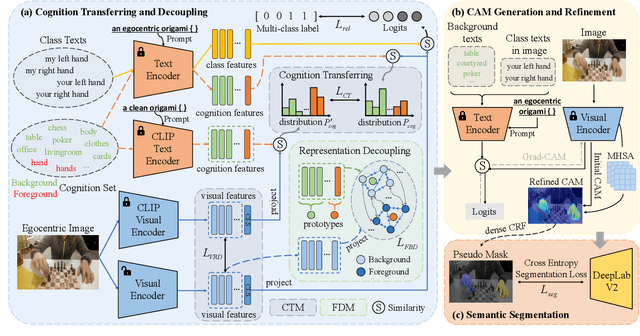
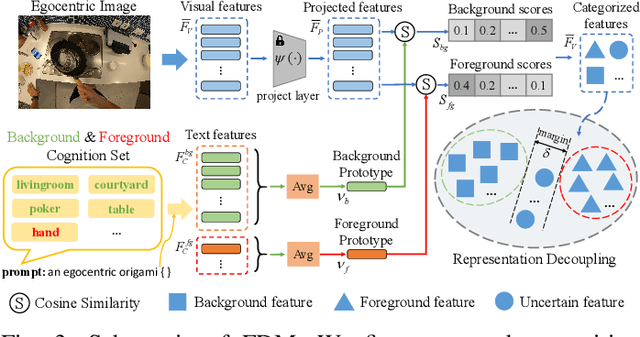
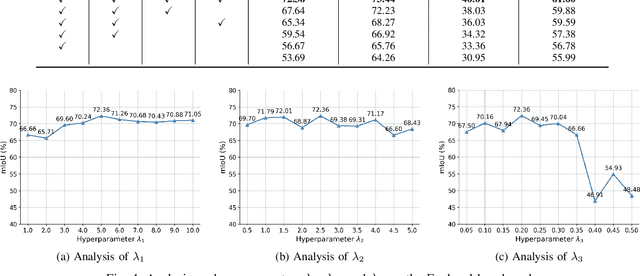
Abstract:In this paper, we explore a novel Text-supervised Egocentic Semantic Segmentation (TESS) task that aims to assign pixel-level categories to egocentric images weakly supervised by texts from image-level labels. In this task with prospective potential, the egocentric scenes contain dense wearer-object relations and inter-object interference. However, most recent third-view methods leverage the frozen Contrastive Language-Image Pre-training (CLIP) model, which is pre-trained on the semantic-oriented third-view data and lapses in the egocentric view due to the ``relation insensitive" problem. Hence, we propose a Cognition Transferring and Decoupling Network (CTDN) that first learns the egocentric wearer-object relations via correlating the image and text. Besides, a Cognition Transferring Module (CTM) is developed to distill the cognitive knowledge from the large-scale pre-trained model to our model for recognizing egocentric objects with various semantics. Based on the transferred cognition, the Foreground-background Decoupling Module (FDM) disentangles the visual representations to explicitly discriminate the foreground and background regions to mitigate false activation areas caused by foreground-background interferential objects during egocentric relation learning. Extensive experiments on four TESS benchmarks demonstrate the effectiveness of our approach, which outperforms many recent related methods by a large margin. Code will be available at https://github.com/ZhaofengSHI/CTDN.
Few-Shot Continual Learning for Activity Recognition in Classroom Surveillance Images
Sep 05, 2024Abstract:The application of activity recognition in the "AI + Education" field is gaining increasing attention. However, current work mainly focuses on the recognition of activities in manually captured videos and a limited number of activity types, with little attention given to recognizing activities in surveillance images from real classrooms. In real classroom settings, normal teaching activities such as reading, account for a large proportion of samples, while rare non-teaching activities such as eating, continue to appear. This requires a model that can learn non-teaching activities from few samples without forgetting the normal teaching activities, which necessitates fewshot continual learning (FSCL) capability. To address this gap, we constructed a continual learning dataset focused on classroom surveillance image activity recognition called ARIC (Activity Recognition in Classroom). The dataset has advantages such as multiple perspectives, a wide variety of activities, and real-world scenarios, but it also presents challenges like similar activities and imbalanced sample distribution. To overcome these challenges, we designed a few-shot continual learning method that combines supervised contrastive learning (SCL) and an adaptive covariance classifier (ACC). During the base phase, we proposed a SCL approach based on feature augmentation to enhance the model's generalization ability. In the incremental phase, we employed an ACC to more accurately describe the distribution of new classes. Experimental results demonstrate that our method outperforms other existing methods on the ARIC dataset.
Distribution-Level Memory Recall for Continual Learning: Preserving Knowledge and Avoiding Confusion
Aug 04, 2024



Abstract:Continual Learning (CL) aims to enable Deep Neural Networks (DNNs) to learn new data without forgetting previously learned knowledge. The key to achieving this goal is to avoid confusion at the feature level, i.e., avoiding confusion within old tasks and between new and old tasks. Previous prototype-based CL methods generate pseudo features for old knowledge replay by adding Gaussian noise to the centroids of old classes. However, the distribution in the feature space exhibits anisotropy during the incremental process, which prevents the pseudo features from faithfully reproducing the distribution of old knowledge in the feature space, leading to confusion in classification boundaries within old tasks. To address this issue, we propose the Distribution-Level Memory Recall (DMR) method, which uses a Gaussian mixture model to precisely fit the feature distribution of old knowledge at the distribution level and generate pseudo features in the next stage. Furthermore, resistance to confusion at the distribution level is also crucial for multimodal learning, as the problem of multimodal imbalance results in significant differences in feature responses between different modalities, exacerbating confusion within old tasks in prototype-based CL methods. Therefore, we mitigate the multi-modal imbalance problem by using the Inter-modal Guidance and Intra-modal Mining (IGIM) method to guide weaker modalities with prior information from dominant modalities and further explore useful information within modalities. For the second key, We propose the Confusion Index to quantitatively describe a model's ability to distinguish between new and old tasks, and we use the Incremental Mixup Feature Enhancement (IMFE) method to enhance pseudo features with new sample features, alleviating classification confusion between new and old knowledge.
No Re-Train, More Gain: Upgrading Backbones with Diffusion Model for Few-Shot Segmentation
Jul 23, 2024Abstract:Few-Shot Segmentation (FSS) aims to segment novel classes using only a few annotated images. Despite considerable process under pixel-wise support annotation, current FSS methods still face three issues: the inflexibility of backbone upgrade without re-training, the inability to uniformly handle various types of annotations (e.g., scribble, bounding box, mask and text), and the difficulty in accommodating different annotation quantity. To address these issues simultaneously, we propose DiffUp, a novel FSS method that conceptualizes the FSS task as a conditional generative problem using a diffusion process. For the first issue, we introduce a backbone-agnostic feature transformation module that converts different segmentation cues into unified coarse priors, facilitating seamless backbone upgrade without re-training. For the second issue, due to the varying granularity of transformed priors from diverse annotation types, we conceptualize these multi-granular transformed priors as analogous to noisy intermediates at different steps of a diffusion model. This is implemented via a self-conditioned modulation block coupled with a dual-level quality modulation branch. For the third issue, we incorporates an uncertainty-aware information fusion module that harmonizing the variability across zero-shot, one-shot and many-shot scenarios. Evaluated through rigorous benchmarks, DiffUp significantly outperforms existing FSS models in terms of flexibility and accuracy.
On the Adversarial Robustness of Learning-based Image Compression Against Rate-Distortion Attacks
May 13, 2024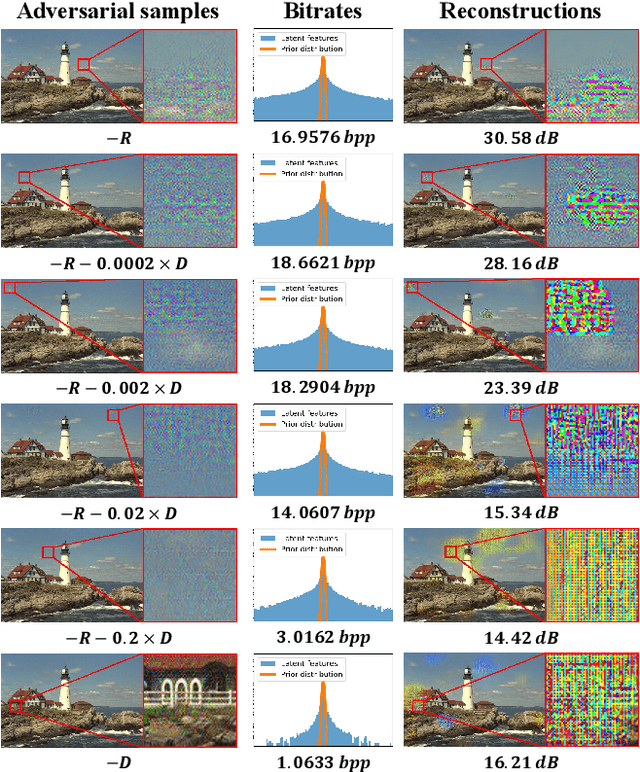
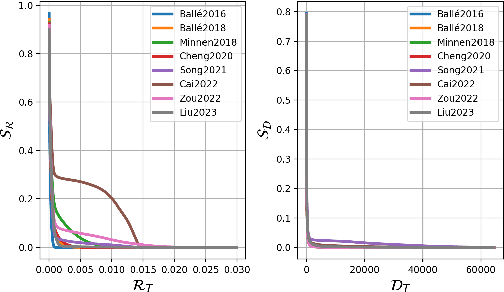
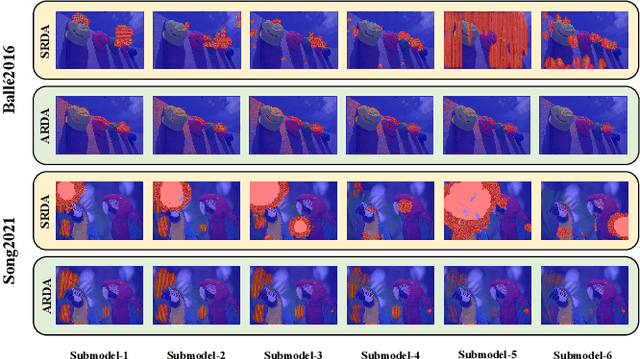

Abstract:Despite demonstrating superior rate-distortion (RD) performance, learning-based image compression (LIC) algorithms have been found to be vulnerable to malicious perturbations in recent studies. Adversarial samples in these studies are designed to attack only one dimension of either bitrate or distortion, targeting a submodel with a specific compression ratio. However, adversaries in real-world scenarios are neither confined to singular dimensional attacks nor always have control over compression ratios. This variability highlights the inadequacy of existing research in comprehensively assessing the adversarial robustness of LIC algorithms in practical applications. To tackle this issue, this paper presents two joint rate-distortion attack paradigms at both submodel and algorithm levels, i.e., Specific-ratio Rate-Distortion Attack (SRDA) and Agnostic-ratio Rate-Distortion Attack (ARDA). Additionally, a suite of multi-granularity assessment tools is introduced to evaluate the attack results from various perspectives. On this basis, extensive experiments on eight prominent LIC algorithms are conducted to offer a thorough analysis of their inherent vulnerabilities. Furthermore, we explore the efficacy of two defense techniques in improving the performance under joint rate-distortion attacks. The findings from these experiments can provide a valuable reference for the development of compression algorithms with enhanced adversarial robustness.
A Deep Learning Method for Beat-Level Risk Analysis and Interpretation of Atrial Fibrillation Patients during Sinus Rhythm
Mar 18, 2024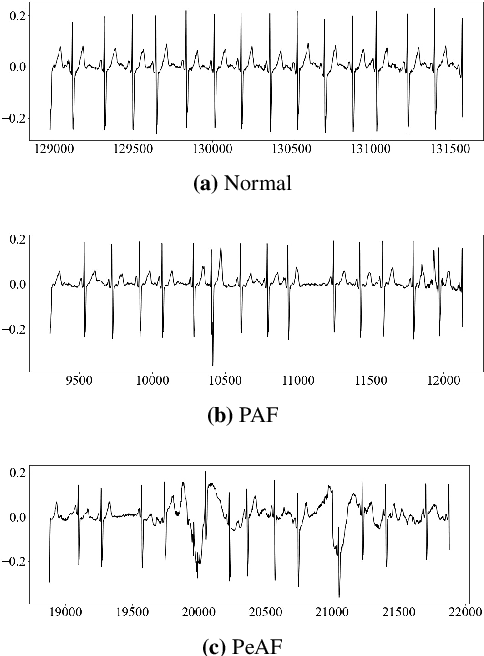


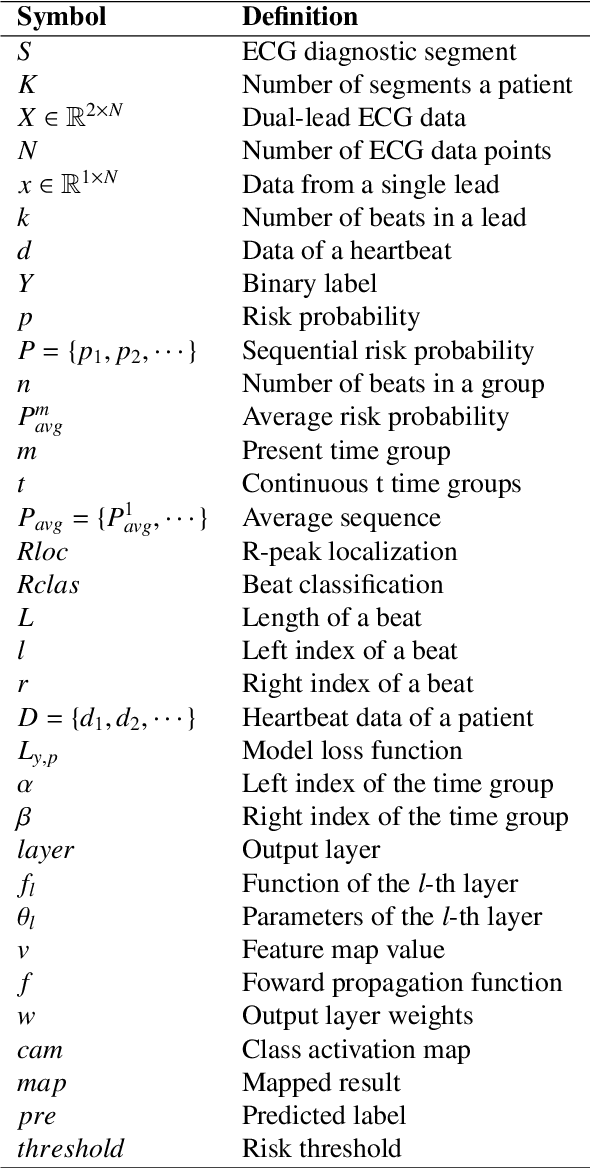
Abstract:Atrial Fibrillation (AF) is a common cardiac arrhythmia. Many AF patients experience complications such as stroke and other cardiovascular issues. Early detection of AF is crucial. Existing algorithms can only distinguish ``AF rhythm in AF patients'' from ``sinus rhythm in normal individuals'' . However, AF patients do not always exhibit AF rhythm, posing a challenge for diagnosis when the AF rhythm is absent. To address this, this paper proposes a novel artificial intelligence (AI) algorithm to distinguish ``sinus rhythm in AF patients'' and ``sinus rhythm in normal individuals'' in beat-level. We introduce beat-level risk interpreters, trend risk interpreters, addressing the interpretability issues of deep learning models and the difficulty in explaining AF risk trends. Additionally, the beat-level information fusion decision is presented to enhance model accuracy. The experimental results demonstrate that the average AUC for single beats used as testing data from CPSC 2021 dataset is 0.7314. By employing 150 beats for information fusion decision algorithm, the average AUC can reach 0.7591. Compared to previous segment-level algorithms, we utilized beats as input, reducing data dimensionality and making the model more lightweight, facilitating deployment on portable medical devices. Furthermore, we draw new and interesting findings through average beat analysis and subgroup analysis, considering varying risk levels.
Learning with Noisy Low-Cost MOS for Image Quality Assessment via Dual-Bias Calibration
Nov 27, 2023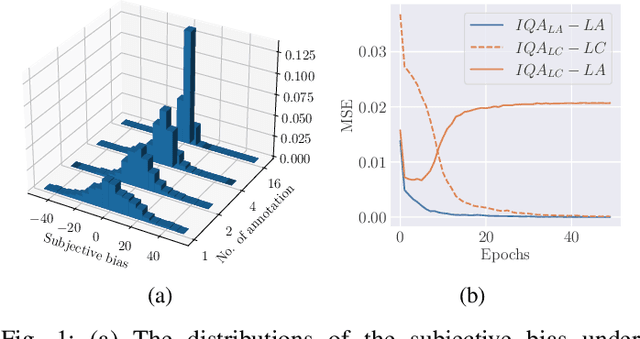
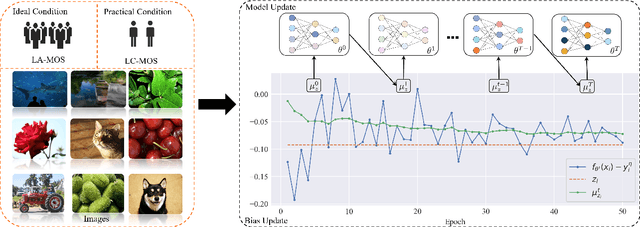
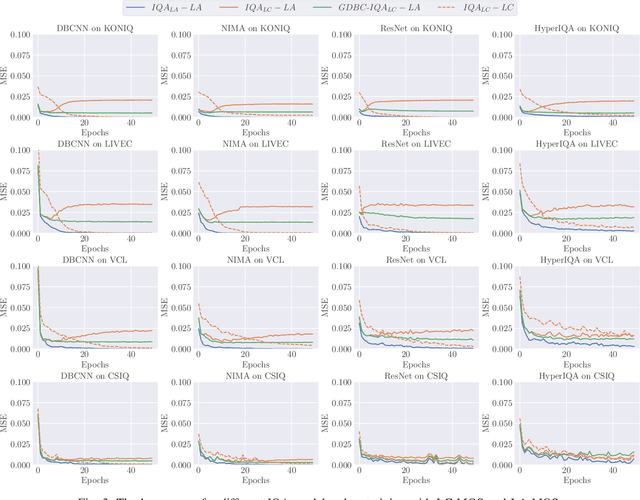
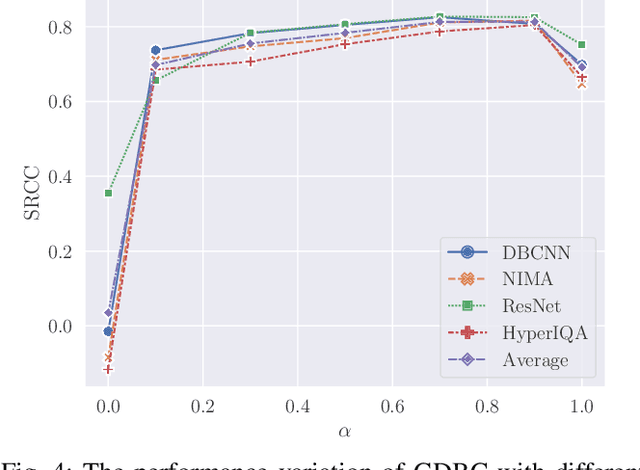
Abstract:Learning based image quality assessment (IQA) models have obtained impressive performance with the help of reliable subjective quality labels, where mean opinion score (MOS) is the most popular choice. However, in view of the subjective bias of individual annotators, the labor-abundant MOS (LA-MOS) typically requires a large collection of opinion scores from multiple annotators for each image, which significantly increases the learning cost. In this paper, we aim to learn robust IQA models from low-cost MOS (LC-MOS), which only requires very few opinion scores or even a single opinion score for each image. More specifically, we consider the LC-MOS as the noisy observation of LA-MOS and enforce the IQA model learned from LC-MOS to approach the unbiased estimation of LA-MOS. In this way, we represent the subjective bias between LC-MOS and LA-MOS, and the model bias between IQA predictions learned from LC-MOS and LA-MOS (i.e., dual-bias) as two latent variables with unknown parameters. By means of the expectation-maximization based alternating optimization, we can jointly estimate the parameters of the dual-bias, which suppresses the misleading of LC-MOS via a gated dual-bias calibration (GDBC) module. To the best of our knowledge, this is the first exploration of robust IQA model learning from noisy low-cost labels. Theoretical analysis and extensive experiments on four popular IQA datasets show that the proposed method is robust toward different bias rates and annotation numbers and significantly outperforms the other learning based IQA models when only LC-MOS is available. Furthermore, we also achieve comparable performance with respect to the other models learned with LA-MOS.
 Add to Chrome
Add to Chrome Add to Firefox
Add to Firefox Add to Edge
Add to Edge